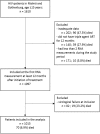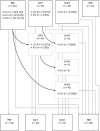Virological failure and all-cause mortality in HIV-positive adults with low-level viremia during antiretroviral treatment
- PMID: 28683128
- PMCID: PMC5500364
- DOI: 10.1371/journal.pone.0180761
Virological failure and all-cause mortality in HIV-positive adults with low-level viremia during antiretroviral treatment
Abstract
Objective: Although most HIV-infected individuals achieve undetectable viremia during antiretroviral therapy (ART), a subset have low-level viremia (LLV) of varying duration and magnitude. The impact of LLV on treatment outcomes is unclear. We investigated the association between LLV and virological failure and/or all-cause mortality among Swedish patients receiving ART.
Methods: HIV-infected patients from two Swedish HIV centers were identified from the nationwide register InfCare HIV. Subjects aged ≥15 years with triple agent ART were included at 12 months after treatment initiation if ≥2 following viral load measurements were available. Patients with 2 consecutive HIV RNA values ≥1000 copies/mL at this time point were excluded. Participants were stratified into four categories depending on viremia profiles: permanently suppressed viremia (<50 copies/mL), LLV 50-199 copies/mL, LLV 200-999 copies/mL and viremia ≥1000 copies/mL. Association between all four viremia categories and all-cause death was calculated using survival analysis with viremia as a time-varying covariate, so that patients could change viremia category during follow-up. Association between the three lower categories and virological failure (≥2 consecutive measurements ≥1000 copies/mL) was calculated in a similar manner.
Results: LLV 50-199 copies/mL was recorded in 70/1015 patients (6.9%) and LLV 200-999 copies/mL in 89 (8.8%) during 7812 person-years of follow-up (median 6.5 years). LLV 200-999 copies/mL was associated with virological failure (adjusted hazard ratio 3.14 [95% confidence interval 1.41-7.03, p<0.01]), whereas LLV 50-199 copies/mL was not (1.01 [0.34-4.31, p = 0.99]; median follow-up 4.5 years). LLV 200-999 copies/mL had an adjusted mortality hazard ratio of 2.29 (0.98-5.32, p = 0.05) and LLV 50-199 copies/mL of 2.19 (0.90-5.37, p = 0.09).
Conclusions: In this Swedish cohort followed during ART for a median of 4.5 years, LLV 200-999 copies/mL was independently associated with virological failure. Patients with LLV had higher rates of all-cause mortality, although not statistically significant in multivariate analysis.
Conflict of interest statement
Figures




References
-
- Bhaskaran K, Hamouda O, Sannes M, Boufassa F, Johnson AM, Lambert PC, et al. Changes in the risk of death after HIV seroconversion compared with mortality in the general population. JAMA. 2008;300(1):51–9. doi: 10.1001/jama.300.1.51 . - DOI - PubMed
-
- Zwahlen M, Harris R, May M, Hogg R, Costagliola D, de Wolf F, et al. Mortality of HIV-infected patients starting potent antiretroviral therapy: comparison with the general population in nine industrialized countries. Int J Epidemiol. 2009;38(6):1624–33. doi: 10.1093/ije/dyp306 - DOI - PMC - PubMed
-
- Gisslen M, Svedhem V, Lindborg L, Flamholc L, Norrgren H, Wendahl S, et al. Sweden, the first country to achieve the Joint United Nations Programme on HIV/AIDS (UNAIDS)/World Health Organization (WHO) 90-90-90 continuum of HIV care targets. HIV Med. 2017;18(4):305–7. doi: 10.1111/hiv.12431 . - DOI - PMC - PubMed
-
- Gunthard HF, Saag MS, Benson CA, del Rio C, Eron JJ, Gallant JE, et al. Antiretroviral Drugs for Treatment and Prevention of HIV Infection in Adults: 2016 Recommendations of the International Antiviral Society-USA Panel. JAMA. 2016;316(2):191–210. doi: 10.1001/jama.2016.8900 . - DOI - PMC - PubMed
-
- British HIV Association. British HIV Association guidelines for the treatment of HIV-1-positive adults with antiretroviral therapy 2015 [internet]. London: British HIV Association; 2015. [cited 7 September 2016]. Available from: http://www.bhiva.org/documents/Guidelines/Treatment/2015/2015-treatmentg....
MeSH terms
Substances
LinkOut - more resources
Full Text Sources
Other Literature Sources
Medical

